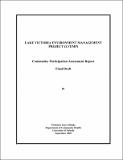| dc.description.abstract | The purpose of the assessment was to review community involvement, performance and
generate a lessons’ learnt report that would contribute to decision-support mechanisms and
inform future interventions. The assessment methodology included extensive review of
relevant documentation, interviews with key informants, specifically the component
coordinators and other stakeholders; field visits to selected project sites, observation and
discussions with community members.
In response to the terms of reference (TORs) and scope of work; the critical question to be
answered was whether the significant role of community participation has been realized as
envisaged in the project document and what evidence there is. To address this question it was
critical to review outputs by objective and components as outlined in the TORs and scope of
work. Across the components the broad guiding questions were: what is the nature of
community participation, achievements and potential for sustainability, the challenges and
lessons learnt from the community as well as project implementation.
The findings indicate that community participation cuts across all components and activities
undertaken by community groups are at various stages of implementation. While microprojects
were a major boost for community participation, community groups were mobilized
and engaged in other activities identified through Participatory Rural Appraisal (PRA) and
flagged as opportunities. This was more evident within the soil and water conservation
component. The activities have both direct and indirect relation to the sustenance of the
environment. These are outlined and discussed within each of the relevant components.
Community participation in the various project components has progressed at different paces.
In general, Water hyacinth, Wetlands, Soil and Water Conservation, and Afforestation have
progressed at a higher pace compared to Capacity building, Fisheries and Water Quality
components. Fisheries Research by its orientation on research had little room for community
participation. However, training in aquaculture was availed to farmers under the Capacity
Building component through the Department of Fisheries, Moi University.
Given the complexity of the project design, LVEMP, embracing the strategy of Community
Participation has done remarkably well. There have been substantial achievements in most of
the project components notably Catchment Afforestation and Soil and Water conservation
where community participation is most evident. Nevertheless, it is observed that if there had
been a more concerted focus on community participation at the inception of the project;
implementation would have been smoother, faster and the achievements would have been greater. | en_US |

